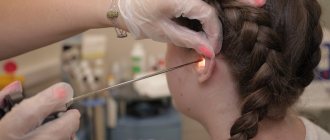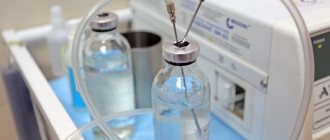Author:
- Khirnetkina Ayuna Fedorovna
otorhinolaryngologist, otoneurologist, audiologist
5.00 (Votes: 1)
The formation of earwax is a physiological process of the protective function of the external auditory canal; earwax is necessary for the normal functioning of the human ear. The main component of earwax is a secretion produced by glands that are located in humans in the deep layers of the skin of the external auditory canal, in its cartilaginous section and open into the hair follicles or into the skin. These are special sweat glands. Earwax also consists of the secretion of the sebaceous glands, which also open into hair follicles, desquamated skin particles, fatty acids, fat-like substances (lanosterol, squalene, cholesterol), mineral salts. Earwax is variable: it has a different smell, consistency and density - from soft, waxy to dry, stony, from light yellow-brown to dark brown, almost black. Representatives of the Mongoloid race have dryer earwax than Europeans, while African Americans have softer earwax. The variability of these qualities of earwax is associated with the genetic characteristics of a person.
Physiological significance of earwax
Earwax performs the following functions:
- a barrier to dust and other small particles, along with short hairs located in the external auditory canal;
- maintaining optimal humidity and temperature in the external auditory canal in various climatic conditions, with fluctuations in ambient temperature and humidity;
- bactericidal, fungicidal effect;
- helps cleanse the external auditory canal by evacuating small foreign components;
- due to the high lipid content, it prevents the penetration of water into the skin of the ear canal and maceration of the skin when water enters the external auditory canal.
These properties of earwax are ensured due to the acidic reaction of the environment, pH 4.5–5.0, and the reaction of the environment in women is more acidic than in men. A change in pH towards the alkaline side is possible with frequent use of hygiene and detergents containing alkali, which contributes to infection of the outer ear. The composition of earwax contains the leading factor of local immunity - secretory immunoglobulin A, as well as lysozyme, antimicrobial fatty acids, and peptides.
Is it possible to cleanse ear wax?
Of course, it is necessary to carry out the procedure of cleansing the ear from accumulated wax.
However, only the outer part of the ear can be cleaned. The inside of the hearing organ does not need to be cleaned. According to experts, ear canal hygiene should be carried out as needed. For these manipulations, it is best to use ordinary clean water. You can combine this procedure with taking a bath/shower. Before cleaning, we recommend that you familiarize yourself with the simple hygiene rules described below.
Sulfur plug
Diseases of the external ear are widespread, and one of the first places in their structure belongs to the cerumen plug (lat. cerumen) - an accumulation of earwax in the external auditory canal, closing its lumen. Under physiological conditions, 15–20 mg of earwax is produced monthly. However, it does not accumulate in excess in the external auditory canal, since it is evacuated from it and subsequently brought out when the lower jaw moves - during conversation and when chewing, as well as in the lateral lying position and when tilting the head. Sulfur plug is formed as a result of excessive production of sulfur by the glands: in patients with metabolic syndrome, hypercholesterolemia, diabetes mellitus.
Among the factors contributing to the formation of sulfur plugs, it should be noted an increase in the viscosity of sulfur, an admixture of desquamated epidermis and small foreign particles.
Factors predisposing to the formation of cerumen plug include such structural features of the external auditory canal as congenital or acquired changes (tortuosity and narrowness), as well as excessive hair growth in the cartilaginous part of the auditory canal. Changes in the formation of earwax are observed with systematic long-term continuous use and insufficient care of the hearing aid and headphones. Of course, preference should be given to full-size headphone models that completely cover the ear.
Factors that increase the likelihood of wax plug formation include water sports, swimming in open water, non-compliance with humidity standards in living quarters, and prolonged stay in a dusty room without personal protective equipment. Therefore, workers in the coal, flour-grinding, and tobacco industries require the mandatory use of special protective equipment.
Improper hygiene of the outer ear, the use of cotton swabs or self-removal of earwax using improvised objects (hairpin, match, etc.) are unacceptable, as they contribute to the pushing of wax into the bony part of the ear canal, irritation and mechanical damage to the skin of the ear canal and can cause otitis externa.
Removing traffic jams
Normally, artificial removal of ear secretions is not required. Spent wax is independently evacuated from the ear during chewing movements. But when obstacles appear that prevent its removal (dense consistency or hypersecretion of sulfuric matter, abnormalities of the ear canals), it accumulates, resulting in the formation of plugs.
Washing the cork with a stream of water
It is impossible to get rid of them on your own; you need to seek help from an otolaryngologist’s office. There are several methods for removing wax plugs from the ears:
- Earwax tells everything about your health
- washing out with a pulsed stream of water (using an electronic irrigator);
- dry removal method using a special probe;
- ear drops that help dissolve the plug and remove it painlessly (three percent hydrogen peroxide, drug A-Cerumen).
The main symptoms of wax plug
- ear congestion;
- autophony - you can hear yourself in this ear;
- hearing loss;
- earache;
- ear noise (monotonous, low-frequency).
The most typical clinical manifestation of wax plug is a sharp decrease in hearing and a feeling of ear fullness, which often occurs suddenly when water gets into the ear canal. Earwax coming into contact with the eardrum can cause painful tinnitus. When accumulated earwax presses on the eardrum, reflex headaches, dizziness, nausea, and cardiac dysfunction are possible. It is extremely important for divers, scuba divers, and divers whose work or hobbies involve long stays under water to remember that they should not perform deep-sea diving when wax accumulates in the ear canal, since a closed space of “relative vacuum” is formed between the wax plug and the eardrum, which can lead to to barometric trauma. In addition, coughing is possible due to a foreign body in the external auditory canal and cerumen plug. A paroxysmal cough can occur when the posterior-inferior wall of the external auditory canal and the posterior quadrant of the eardrum are irritated.
Violation of the protective properties of earwax, its absence or infection can cause the development of external otitis.
Reasons for changes in color and consistency
Change in earwax color during illness
Normally, earwax is a brown substance with a viscous consistency. Depending on the state of organs and systems, the color and density of sulfuric matter may change, which serves as the first sign of an incipient disease:
- The dark color of sulfur is a symptom of a hereditary pathology in which the tissue of blood vessels is damaged. It is called Randu-Osler-Weber syndrome. Another common symptom of this pathology is nosebleeds.
- Yellowish or green wax indicates a purulent process in one of the ear structures. The following symptoms accompany the pathology: acute pain in the ear, fever, intoxication, lymphadenitis. Before prescribing treatment, the doctor identifies the nature of the pathogenic microflora.
- Black sulfur (or sulfur that has a red tint) indicates that blood clots are present in the sulfur substance. This may indicate an injury to the eardrum or a tumor process in the auditory canal. This sulfur is a symptom of a fungal infection (otomycosis).
- Gray color indicates the presence of a large amount of dust in the sulfuric matter.
- White sulfur is a symptom of hypovitaminosis and a lack of certain microelements. In this case, copper or iron deficiency is most likely.
- Dry sulfur is a symptom of dermatitis and other skin diseases.
- Liquid, flowing sulfur appears when the eardrum is perforated or there is an inflammatory process in the ear.
Causes of earwax hypersecretion, ways to eliminate them
Sometimes more wax is produced than necessary, causing it to accumulate in the ear canal. If the viscosity of the secretion is low, then it will constantly flow out, seriously disturbing the person. Otherwise, traffic jams will form. Typical causes of excessive sulfur formation include:
- Chronic dermatitis . The disease manifests itself in the form of red spots located in a specific place or throughout the body. Treatment depends on the cause (allergy or infection). It is possible to prescribe anti-inflammatory and antihistamine drugs. With the disease, there may be little or a lot of wax in the ears, and sometimes its consistency changes.
- Excessive amount of cholesterol in the blood . This condition does not have specific symptoms, but can manifest itself in pain in the legs with increased physical activity, yellowing of the skin. The basis of treatment is a special diet, and sometimes it may be necessary to take cholesterol-lowering drugs.
- Constantly wearing headphones or hearing aids . When an object is kept inside the ear canal all the time, it stimulates the glands located there. As a result, they separate much more secretion than is necessary.
- Staying and working in a heavily dusty area . In this case, dirt particles enter the ear and activate the production of wax. This situation is normal, it indicates good functioning of the glands.
- Stress . The American Association ASHA has published research that states that stressful life situations increase the activity of all glands. If a person tends to sweat before an important speech or report, the amount of earwax in his ear will also increase.
Violations in sulfur evacuation
The most common cause of difficult transport is the constant presence of a foreign object in the ear. This could be a hearing aid, headphones or earplugs. The sulfur accumulates and thickens. When you try to remove it yourself, it is pushed even deeper. Water can cause it to swell and form a full-blown sulfur plug.
In this case, the following symptoms will be observed:
- Itching.
- Feeling of ear fullness.
- Partial deafness.
How to clear wax from ears?
Is it painful to remove wax plug? There is no sharp pain, there may be some discomfort. If you are prone to wax, the best way to remove excess wax and clean your ears is to use a soft cloth. In some cases, as prescribed by a doctor, you can use softening solutions - mineral oil, glycerin, peroxide solutions, hydrogen peroxide.
If the wax plug is not softened with solutions, the doctor can use rinsing - using a syringe to rinse the ear canal with saline solution or water. Rinsing is done after using the drops - this enhances the effect.
Note: Irrigation is contraindicated for people with ruptured eardrums. If you suspect a ruptured ear tube or other injury, you should consult a doctor immediately. Making decisions on your own often makes the situation worse.
So how can you properly clean your child’s ears?
In order to eliminate negative deterioration and difficulties with the child’s hearing, it is necessary to try to clean the child’s ear canals as little as possible. However, sometimes care is still required. As soon as the child has taken a bath, once a week, experts recommend ear prevention, but only if he is already a teenager. However, it is recommended to only wipe it to remove any residue. Only the main area where the hole is located should be cleaned. And then in the presence of a visible accumulation of sulfuric matter. It is strictly forbidden to climb into the deep hole itself. It is necessary to take into account the fact that in a small child the ear opening with the presence of an eardrum has not fully formed. And the membrane itself is located close to the hole. For this reason, cleaning the ears of children under 1 year of age is extremely dangerous.
What is recommended for cleaning children's ears?
It is not recommended to use sticks with cotton wool on the tip or other objects to clean the ear septum. For these purposes, pharmacies sell specialized devices in the form of the same sticks that have a limiter. Such devices are able to penetrate deep into the ear opening to a safe distance. However, their use is by no means necessary.
Turundas with cotton wool are not recommended for use. During the screwing procedure, they leave lint in the ear hole, which will subsequently lead to inflammation. Most often, self-cleaning of the ear hole leads to thickening of the wax plug inside the ear and pushing it even further into the ear. At the same time, even sticks with a limiter are not able to help in this situation.
The most reliable way to clean a child's ears may be a 3% solution with hydrogen peroxide. It is only necessary that it be as fresh as possible. The technique should only be used on the recommendation of an appropriate doctor.
It is necessary to drop the child into each ear separately. The solution will begin to fizz and then rise up and push all the contents out of the ear hole to the surface. After this, you just need to wipe your ears with cotton wool.
To use the technique comfortably, you should arm yourself with a slightly warmed pipette in your hands. Using a pipette, sequentially drip into the ear openings.
How to prevent problems with sulfur production?
To prevent disruption of wax production, do not insert anything into your ears to clean them. Use cotton swabs to clean the outer surface. If you often have wax plugs, then you need to remove it with the help of a specialist at least once a year. Talk to your doctor about which methods to prevent excess wax production may work best for you.
Why do some people experience wax plugs? Every body produces earwax, but in varying amounts, which depend on a person's genetics.
How to remove wax from ears? Due to the special structure of the ear, removing wax from it is not difficult. Jaw movements move the ear canal and help push wax out. For people whose ear canals are smaller than standard or have a large curve, cleaning with a Q-tip can cause injury.
Introduction
The ear is an important organ for cognition of the surrounding world.
But at the same time, it is also a “gateway” for the entry of various infections. To prevent negative influences from the outside, there is a special secret in the ears - earwax . It is a viscous substance, usually dark yellow to brown, produced in the ear canal of all mammals, including humans.
Sulfur
Hundreds of years ago, sulfur was associated almost exclusively with volcanoes, hellish cauldrons and sinners.
Then there was the era of gunpowder. And with the beginning of the scientific and technological revolution, the vulcanization of rubber, the production of chemical warfare agents, the synthesis of polymers, medicines and other attributes of modern civilization suddenly appeared. Polymers and drugs are about us. We deal in medical products and use organically bound sulfur that kills demodex mites.
Sulfur also burns in ultraviolet light, so many fire sensors do not detect its ignition. This is important to protect production.
Combustion
For 500 years, sulfur was the main component of almost the only explosive available to man.
Sulfur in powder form is quite explosive and therefore was included in black powder. In air, sulfur burns to form sulfur dioxide, a colorless gas with a pungent odor. The gas is quite poisonous and upon contact with water in the lungs it turns into sulfurous acid. It is on this property that the method of quickly cleaning vegetable stores, barns and basements from various pests is based. A sulfur bomb is lit in the room, and after a few hours there is no one alive left there. Sulfur is also known for its compound, hydrogen sulfide, which has a characteristic rotten egg smell. More precisely, it is the eggs that smell of it when decomposing. It is formed during the decay of proteins that are present in the composition (only those that contain the sulfur-containing amino acids methionine or cysteine). This gas is formed in large quantities during the decomposition of organic matter and therefore is especially common in various sewers along with methane. Methane is non-toxic and does not pose a breathing hazard until it displaces oxygen. But hydrogen sulfide is extremely toxic. Moreover, it causes a failure of the olfactory receptors, its smell is no longer felt. People who go down into wells and various sewer manholes lose consciousness after a couple of breaths and quickly die.
A typical case is carbon monoxide poisoning.
But what will happen if you set fire to such a hatch:
They were even luckier compared to the astronaut candidates:
Earwax
What you can get out of your ear does not actually contain wax as such. It's just that the Latin name cerumen is similar. Produced by sulfur (ceruminous) glands and consists of proteins, fats, free fatty acids and mineral salts. The main function is protection from dust, bacteria, fungi and other unfriendly organisms.
Mercaptan aromas
These are thiols. They smell. Storing them in an airtight safe in containers with a lid and placing a double bag on top will not help. This is what a skunk smells like after being left in the heat for two weeks. It is almost impossible to remove the smell from your hands.
One of the most common applications of thiols is the odorization of domestic gas. Methane, butane and propane do not smell at all, and installing sensors for their leakage is quite expensive. A simple solution was found - the gas should smell unpleasant. Moreover, the amount of mercaptan there is very tiny - 10−7−10−8 mol/l.
How syphilis was treated with malaria
The spirochete has four subspecies and causes not only the well-known syphilis, but also lesser-known diseases such as yaws, pinta and bejel. Yaws generally spreads through contact and primarily affects children. It can be treated quite well with penicillins and macrolides, so outbreaks are present mainly in poor tropical countries. Treponema is a pure anthroponosis, that is, only humans can be carriers. They have been successfully parasitizing us for at least 1.2 million years. Nowadays syphilis can be treated quite quickly and without any problems, but before, particularly loving individuals gradually turned into walking zombies over the course of several years. Antibiotics became widespread only during World War II, but treatment for syphilis was required at least long before that. Doctors regularly conducted experiments, sometimes even on themselves. John Hunter, for example, voluntarily infected himself with syphilis and gonorrhea to test his hypotheses. Following the traditions of his time, he managed to recover with rather toxic mercury preparations and cauterizations.
A rather unexpected solution to the problem came from another area - psychiatry. There, too, the treatment of patients was difficult and new methods were invented with enviable regularity. After much experimentation, the Austrian psychiatrist Julius Wagner-Jauregg proposed a method for treating psychosis with high fever. As it turned out, treponema pallidum also tolerates hyperthermia very poorly and dies quickly.
A patient with syphilis was also infected with malaria. After a few weeks of severe fever, the treponema died, and they already knew how to fight malaria - quinine and methylene blue. A little later, to create an artificial fever, they began to use the already familiar sulfur in the form of a suspension in peach oil - sulfozine. Injection of a similar mixture into the thigh muscles caused a rise in temperature to 39–40 °C and extremely painful sensations at the injection site. Years later, antibiotics appeared, but pyrotherapy gained a foothold in other areas of medicine - in particular, in a certain percentage of cases, positive dynamics were described in patients with schizophrenia. Now they have abandoned sulfozine and most often use lipopolysaccharide from the causative agent of typhoid fever. Mainly to transfer chronic infectious diseases into the acute phase for effective treatment.
Here is a similar method of treating gonorrhea, which is given by Nikolai Nikulin in the book “Memories of the War”:
“Faced with an epidemic of sexually transmitted diseases, doctors were at first confused. There are few medicines, and even fewer specialists. Tripper was treated in a barbaric way: several cubes of milk were injected into the patient’s buttock, an abscess formed, and the temperature rose above forty degrees. The bacillus, as you know, cannot tolerate such heat. Then the abscess was treated. Sometimes it helped. It was worse with syphilitics. I was told that they were gathered in the city of Neyrupin in a special camp and were kept behind barbed wire for some time, waiting for medicines that were not yet available.”
Sulfur in cosmetology
Sulfur is one of the most important biogenic elements: it is part of some amino acids (cysteine, methionine), vitamins (biotin, thiamine) and enzymes.
Works as a cross-linker, forming disulfide bridges and forming the tertiary structure of the protein. One kilogram of human meat contains about two grams of sulfur. Without it, normal hair growth is impossible, since their structural proteins contain sulfur-containing methionine.
And cosmetologists also love it. And grandmothers who are sure that the effect of the ointment is directly proportional to its smell. Sulfur-containing gels and ointments have a pronounced antiseptic and antiparasitic effect. When sulfur interacts with organic substances, sulfides and pentathionic acid are formed, which give it these properties.
Remember those cute mites that live in your skin? It is they who sadly begin to die of hunger due to the fact that sulfur changes the characteristics of sebum. At the same time, its antimicrobial effect is manifested due to the suppression of the growth of bacterial microflora. For this purpose, we have specially developed the “Demoten” gel, which is balanced in its composition, which, on the one hand, gives the desired therapeutic effect, and on the other hand, gives almost no allergic side effects, like harsh smelling sulfur suspensions. We also use it in the “Blepharogel 2” product, but only for eyelid skin care. It is delicate, so the composition is also very delicate.
Sulfur can cause allergies, although quite rarely, but when working with it you need to know very precisely which compounds you need to use in the finished product. This part of the story is already a trade secret, and, as far as we know, in the field of eyelid skin gels we are still one of the best in the world. Again, thanks to the science of the USSR: most of our developments are a continuation of the polymer themes of the Soviet research institute, where we all came from.
When is it necessary to contact a specialist?
It's hard to know when exactly your ears will need cleaning. If you notice a periodic build-up of earwax, try synchronizing your cleansing schedule to resolve the problem. If you suffer from ear pain, whistling when using hearing aids, or excessively dirty hearing aids, contact your doctor or your hearing care professional immediately. Under no circumstances should patients with perforated eardrums or ear infections perform self-cleaning.
Based on materials from signia-hearing.ru
How to clear wax from ears?
Is it painful to remove wax plug? There is no sharp pain, there may be some discomfort. If you are prone to wax, the best way to remove excess wax and clean your ears is to use a soft cloth. In some cases, as prescribed by a doctor, you can use softening solutions - mineral oil, glycerin, peroxide solutions, hydrogen peroxide.
If the wax plug is not softened with solutions, the doctor can use rinsing - using a syringe to rinse the ear canal with saline solution or water. Rinsing is done after using the drops - this enhances the effect.
Note: Irrigation is contraindicated for people with ruptured eardrums. If you suspect a ruptured ear tube or other injury, you should consult a doctor immediately. Making decisions on your own often makes the situation worse.
Composition and functions of sulfur
The auditory canal is part of the outer ear, i.e. it is in direct contact with the environment. It is covered with thin skin, its thickness is 1-2 mm. It contains abundant sebaceous and sulfur glands. They secrete a liquid secretion. It mixes with dead skin cells to form earwax. Normally, it has a brown color, a paste-like consistency, and almost no odor.
Evacuation of wax occurs spontaneously; accumulations can be found at the entrance to the auditory canal. From there it is washed off with soapy water or removed with a dry cotton pad. No other hygiene procedures are normally required.
Sulfur helps cleanse the outer ear of various impurities. All small dust particles, fungal spores (including pathogenic ones), as well as bacteria and viruses enter the resulting lump and are excreted from the body. This self-cleaning of the canal prevents the development of colonies of pathogenic microorganisms on its skin, which, when the immune status is reduced, can cause inflammation.










